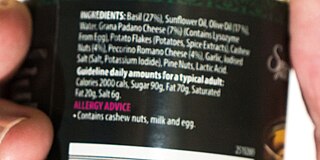
Glaucoma is a group of eye diseases that result in damage to the optic nerve and cause vision loss. The most common type is open-angle glaucoma, in which the drainage angle for fluid within the eye remains open, with less common types including closed-angle glaucoma and normal-tension glaucoma. Open-angle glaucoma develops slowly over time and there is no pain. Peripheral vision may begin to decrease, followed by central vision, resulting in blindness if not treated. Closed-angle glaucoma can present gradually or suddenly. The sudden presentation may involve severe eye pain, blurred vision, mid-dilated pupil, redness of the eye, and nausea. Vision loss from glaucoma, once it has occurred, is permanent. Eyes affected by glaucoma are referred to as being glaucomatous.

The National Eye Institute (NEI) is part of the U.S. National Institutes of Health (NIH), an agency of the U.S. Department of Health and Human Services. The mission of NEI is “to eliminate vision loss and improve quality of life through vision research.” NEI consists of two major branches for research: an extramural branch that funds studies outside NIH and an intramural branch that funds research on the NIH campus in Bethesda, Maryland. Most of the NEI budget funds extramural research.

Macular degeneration, also known as age-related macular degeneration, is a medical condition which may result in blurred or no vision in the center of the visual field. Early on there are often no symptoms. Over time, however, some people experience a gradual worsening of vision that may affect one or both eyes. While it does not result in complete blindness, loss of central vision can make it hard to recognize faces, drive, read, or perform other activities of daily life. Visual hallucinations may also occur.

Betaxolol is a selective beta1 receptor blocker used in the treatment of hypertension and angina. Being selective for beta1 receptors, it typically has fewer systemic side effects than non-selective beta-blockers, for example, not causing bronchospasm as timolol may. Betaxolol also shows greater affinity for beta1 receptors than metoprolol. In addition to its effect on the heart, betaxolol reduces the pressure within the eye. This effect is thought to be caused by reducing the production of the liquid within the eye. The precise mechanism of this effect is not known. The reduction in intraocular pressure reduces the risk of damage to the optic nerve and loss of vision in patients with elevated intraocular pressure due to glaucoma.

Latanoprost, sold under the brand name Xalatan among others, is a medication used to treat increased pressure inside the eye. This includes ocular hypertension and open angle glaucoma. It is applied as eye drops to the eyes. Onset of effects is usually within four hours, and they last for up to a day.
Neovascularization is the natural formation of new blood vessels, usually in the form of functional microvascular networks, capable of perfusion by red blood cells, that form to serve as collateral circulation in response to local poor perfusion or ischemia.

Anecortave (rINN) is a novel angiogenesis inhibitor used in the treatment of the exudative (wet) form of age-related macular degeneration. Although similar in chemical structure to the corticosteroid hydrocortisone acetate, it possesses no glucocorticoid activity. If it is approved, it will be marketed by Alcon as anecortave acetate for depot suspension under the trade name Retaane. No development has been reported since 2010.

Brimonidine is a medication used to treat open-angle glaucoma, ocular hypertension, and rosacea. In rosacea it improves the redness. It is used as eye drops or applied to the skin.

Dorzolamide, sold under the brand name Trusopt among others, is a medication used to treat high pressure inside the eye, including in cases of glaucoma. It is used as an eye drop. Effects begin within three hours and last for at least eight hours. It is also available as the combination dorzolamide/timolol.

Levobunolol is a non-selective beta blocker. It is used topically in the form of eye drops to manage ocular hypertension and open-angle glaucoma.

Levobetaxolol is a drug used to lower the pressure in the eye in treating conditions such as glaucoma. It is marketed as a 0.25 or 0.5% ophthalmic solution of levobetaxolol hydrochloride under the trade name Betaxon. Levobetaxolol is a beta-adrenergic receptor inhibitor.

Blurred vision is an ocular symptom where vision becomes less precise and there is added difficulty to resolve fine details.
Retinal gene therapy holds a promise in treating different forms of non-inherited and inherited blindness.
Flammer syndrome is a described clinical entity comprising a complex of clinical features caused mainly by dysregulation of the blood supply. It was previously known as vascular dysregulation. It can manifest in many symptoms, such as cold hands and feet, and is often associated with low blood pressure. In certain cases it is associated with or predisposes to the development of diseases such as a normal tension glaucoma. Flammer syndrome is named after the Swiss ophthalmologist Josef Flammer.

Josef Flammer is a Swiss ophthalmologist and long-time director of the Eye Clinic at Basel University Hospital. Flammer is a glaucoma specialist who developed a new pathogenetic concept of glaucomatous damage according to which unstable blood supply leads to oxidative stress, which in turn plays a major role in apoptosis of cells in the optic nerve and retina in glaucoma patients.
Ripasudil, a derivative of fasudil, is a rho kinase inhibitor drug used for the treatment of glaucoma and ocular hypertension.
Anti–vascular endothelial growth factor therapy, also known as anti-VEGF therapy or medication, is the use of medications that block vascular endothelial growth factor. This is done in the treatment of certain cancers and in age-related macular degeneration. They can involve monoclonal antibodies such as bevacizumab, antibody derivatives such as ranibizumab (Lucentis), or orally-available small molecules that inhibit the tyrosine kinases stimulated by VEGF: sunitinib, sorafenib, axitinib, and pazopanib.
Photostress recovery time (PSRT) is the time taken for visual acuity to return to normal levels after the retina has been bleached by a bright light source. Photostress recovery time measurement procedure is known as photostress test. Normal recovery time is about 15–30 seconds.

Secondary glaucoma is a collection of progressive optic nerve disorders associated with a rise in intraocular pressure (IOP) which results in the loss of vision. In clinical settings, it is defined as the occurrence of IOP above 21 mmHg requiring the prescription of IOP-managing drugs. It can be broadly divided into two subtypes: secondary open-angle glaucoma and secondary angle-closure glaucoma, depending on the closure of the angle between the cornea and the iris. Principal causes of secondary glaucoma include optic nerve trauma or damage, eye disease, surgery, neovascularization, tumours and use of steroid and sulfa drugs. Risk factors for secondary glaucoma include uveitis, cataract surgery and also intraocular tumours. Common treatments are designed according to the type and the underlying causative condition, in addition to the consequent rise in IOP. These include drug therapy, the use of miotics, surgery or laser therapy.

Uveitic glaucoma is most commonly a progression stage of noninfectious anterior uveitis or iritis.














